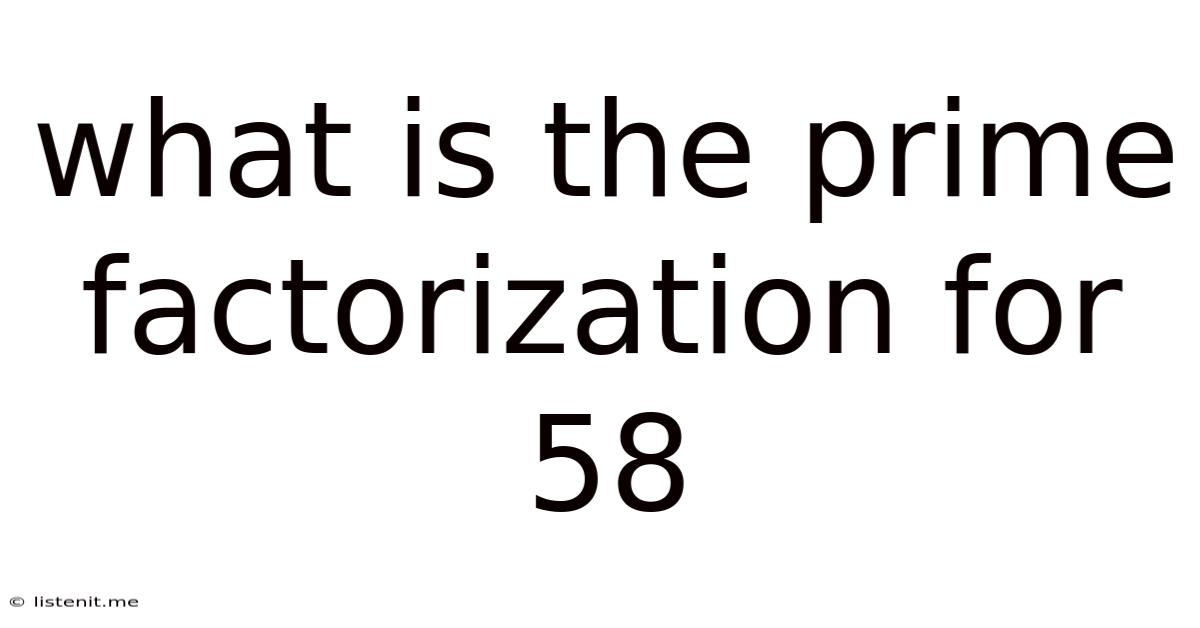What Is The Prime Factorization For 58
listenit
May 10, 2025 · 4 min read

Table of Contents
What is the Prime Factorization for 58? A Deep Dive into Prime Numbers and Factorization
Finding the prime factorization of a number might seem like a simple mathematical exercise, but it's a fundamental concept with far-reaching applications in number theory, cryptography, and computer science. This article delves into the prime factorization of 58, explaining the process step-by-step and exploring the broader context of prime numbers and factorization techniques. We'll also look at how this seemingly simple calculation contributes to more advanced mathematical concepts.
Understanding Prime Numbers
Before we tackle the prime factorization of 58, let's define what a prime number is. A prime number is a natural number greater than 1 that has no positive divisors other than 1 and itself. In simpler terms, it's only divisible by 1 and itself. The first few prime numbers are 2, 3, 5, 7, 11, 13, and so on. The number 1 is not considered a prime number.
Key characteristics of prime numbers:
- Divisibility: A prime number is only divisible by 1 and itself.
- Infinitude: There are infinitely many prime numbers. This was proven by Euclid centuries ago.
- Fundamental Theorem of Arithmetic: Every integer greater than 1 can be uniquely represented as a product of prime numbers (ignoring the order of the factors). This theorem is crucial to understanding prime factorization.
What is Prime Factorization?
Prime factorization is the process of breaking down a composite number (a number that is not prime) into its prime factors. This means expressing the number as a product of prime numbers. Each composite number has only one unique prime factorization, regardless of the order of the factors. This uniqueness is guaranteed by the Fundamental Theorem of Arithmetic mentioned above.
For example, the prime factorization of 12 is 2 x 2 x 3, often written as 2² x 3. This means that 12 can be expressed as the product of the prime numbers 2 and 3.
Finding the Prime Factorization of 58
Now, let's determine the prime factorization of 58. We'll use a method called the factor tree.
-
Start with the number 58. Since 58 is an even number, we know it's divisible by 2.
-
Divide 58 by 2: 58 / 2 = 29
-
Examine the result: We get 29. 29 is a prime number because its only divisors are 1 and 29.
Therefore, the prime factorization of 58 is 2 x 29.
We can represent this visually using a factor tree:
58
/ \
2 29
This tree shows that 58 branches into its prime factors, 2 and 29.
Alternative Methods for Finding Prime Factorization
While the factor tree method is intuitive and easy to visualize, especially for smaller numbers, other methods exist for finding prime factorizations, particularly useful for larger numbers:
-
Division by Primes: Start dividing the number by the smallest prime number (2). If it's divisible, continue dividing the quotient by 2 until it's no longer divisible. Then move to the next prime number (3), and so on. This process continues until the quotient is 1. The prime numbers used in the divisions are the prime factors.
-
Sieve of Eratosthenes: This is a method for finding all prime numbers up to a specified integer. While not directly a prime factorization method, it's a valuable tool for identifying potential prime factors. It involves creating a list of numbers and systematically eliminating composite numbers.
Applications of Prime Factorization
The seemingly simple process of prime factorization has significant applications in various fields:
-
Cryptography: Public-key cryptography, such as RSA, relies heavily on the difficulty of factoring large composite numbers into their prime factors. The security of many online transactions depends on this computational challenge.
-
Number Theory: Prime factorization is a fundamental concept in number theory, used to prove theorems, explore patterns, and understand the properties of integers.
-
Computer Science: Algorithms for prime factorization are used in various computer science applications, such as generating unique identifiers, and data compression.
-
Coding Theory: Prime numbers play a vital role in error correction codes, ensuring reliable data transmission.
Beyond 58: Exploring Larger Numbers and Challenges
While finding the prime factorization of 58 was straightforward, factoring larger numbers can be significantly more challenging. As numbers grow, the computational effort required to find their prime factors increases dramatically. This computational complexity is what makes prime factorization so crucial for cryptographic security.
There is ongoing research into finding more efficient algorithms for prime factorization. However, for extremely large numbers, finding the prime factorization remains a computationally intensive task.
Conclusion: The Importance of Prime Factorization
The prime factorization of 58, seemingly a simple calculation (2 x 29), serves as a gateway to understanding a fundamental concept in mathematics with profound implications. The ability to break down numbers into their prime factors is essential in various fields, highlighting the importance of this mathematical concept beyond its apparent simplicity. From ensuring the security of online transactions to advancing our understanding of numbers themselves, the power of prime factorization is undeniable. Understanding this fundamental principle is key to grasping more complex mathematical and computational concepts. It's a testament to the elegance and power of seemingly simple mathematical ideas.
Latest Posts
Latest Posts
-
35 Is 70 Percent Of What Number
May 10, 2025
-
What Is The Greatest Common Factor Of 15 And 24
May 10, 2025
-
What Is The Similarity Between A Compound And A Mixture
May 10, 2025
-
Is H2s A Acid Or Base
May 10, 2025
-
Soda Fizzing Physical Or Chemical Change
May 10, 2025
Related Post
Thank you for visiting our website which covers about What Is The Prime Factorization For 58 . We hope the information provided has been useful to you. Feel free to contact us if you have any questions or need further assistance. See you next time and don't miss to bookmark.